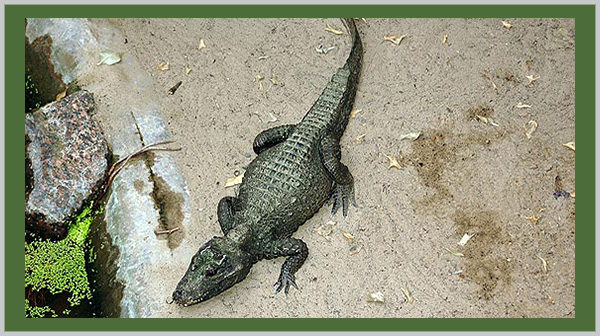
Dwarf Crocodile
Name: Dwarf Crocodile (Osteolaemus tetraspis)
Conservation Status: Vulnerable (2021 IUCN Red List)
Population Estimate: Unspecified / Severely Fragmented
Range: Tropical Rain Forests of West and Central Africa.
Threats: Habitat Destruction / Hunting
Crocodilians were once abundant in many tropical waters around the world. Crocodiles, along with their relatives the alligators, caimans, and gavials, are ancient animals that walked the Earth alongside the dinosaurs. Throughout history, crocodiles, including the dwarf crocodile have been both feared and respected by people. The ancient Egyptians believed crocodiles were a river god that had to be appeased by the annual sacrifice of a beautiful virgin.
The art of some African peoples depicts crocodiles as water spirits and messengers to the supernatural world. This reverence, however, has not spared crocodilians from destruction at the hand of humans.
Species Description and Range
The dwarf crocodile, at no more than 5 feet (1.5 m) long, is the smallest of 3 species of crocodile which occur in Africa. It is found in swamps and slow-moving streams in the Tropical rain forests of West and Central Africa. The dwarf crocodile is now regarded as rare throughout its range.
Natural History
Timid and slow moving, the dwarf crocodile is active mostly at night. All crocodiles are carnivores (meat eaters); they eat fish, birds, snakes, frogs, carrion, and any mammals that they can catch. Except in the case of the largest of crocodilians, the huge salt water crocodile of Australia and New Guinea, humans are rarely a prey item. Crocodilians are known to prey upon domestic animals, however.
The dwarf crocodile nests in mounds of vegetation near water, and it is dependent upon the heat generated by the decaying vegetation to incubate its small clutch of eggs.
Crocodile parents are more attentive to their young than any other group of reptiles. Baby crocodiles live a perilous life from the moment they hatch. They are eaten by birds, fish, small predators such as mongoose and civets, and even larger crocodiles. Often, the adults will carry and protect their young inside their fearsome-toothed jaws.
Causes of Endangerment
Bounty and Trophy Hunting
People have long considered crocodiles vermin or a dangerous nuisance. For this reason, crocodiles have been hunted to extinction in some places, particularly as cattle ranching encroaches on crocodile habitat.
The American alligator was targeted as a problem animal and wiped out in many areas in the southern United States. After European colonization of Africa, the governments of many countries paid a high bounty for every crocodile killed in order to make the countryside safer for people and grazing cattle. The large Nile crocodiles were also sought after as sport trophies for hunters on safari.
Habitat Loss
Habitat loss continues to threaten crocodiles, most notably by drainage and filling of wetlands and diversion of water for irrigation. Crocodiles also have been pushed out of former homes by growing cities and farms on the shores of lakes and rivers.
Conservation Actions
Regulation of Trade
Since 1973, every species of crocodile has been protected to some degree under CITES. Although poaching is still a problem, it has been greatly reduced. In 1990, the International Union for the Conservation of Nature (IUCN) reported that as a direct result of curtailing much of the illegal trade, the condition of most crocodilian species has improved. The IUCN pronounced the dwarf crocodile “secure in some or most populations.”
Habitat Protection
Wetlands conservation is key to crocodile survival and also will benefit other wetland-dependent species. Intensive and coordinated efforts which include habitat protection have been undertaken to save crocodilian species such as the gharial. In India, gharial eggs are collected and incubated in captivity, young are raised past the age of maximum mortality, and then the eggs are released into protected wetland reserves.
Accompanied by education of local peoples to reduce hunting, this program seems to be slowly increasing wild populations of gharial.
Questions for Thought
Do you think farming of crocodilians is the solution to saving wild populations?
Crocodilians inhabit warm waterways and coastal areas around the world. Can you think of other animals which might benefit from protection of crocodilian habitat?
Explore:
Related Classroom Activities:
[CS1-1, CS1-4, CS2-7, General]
Click here for Endangered Species Classroom Glossary